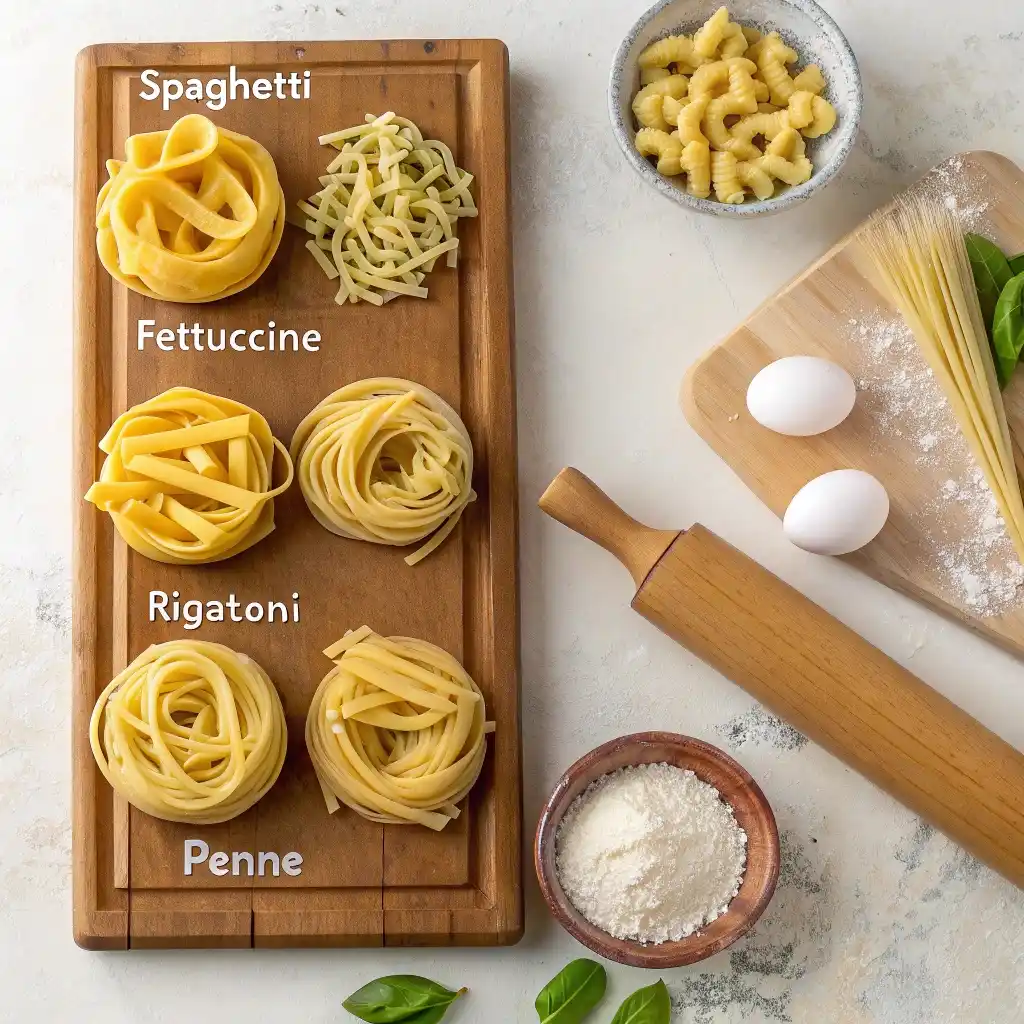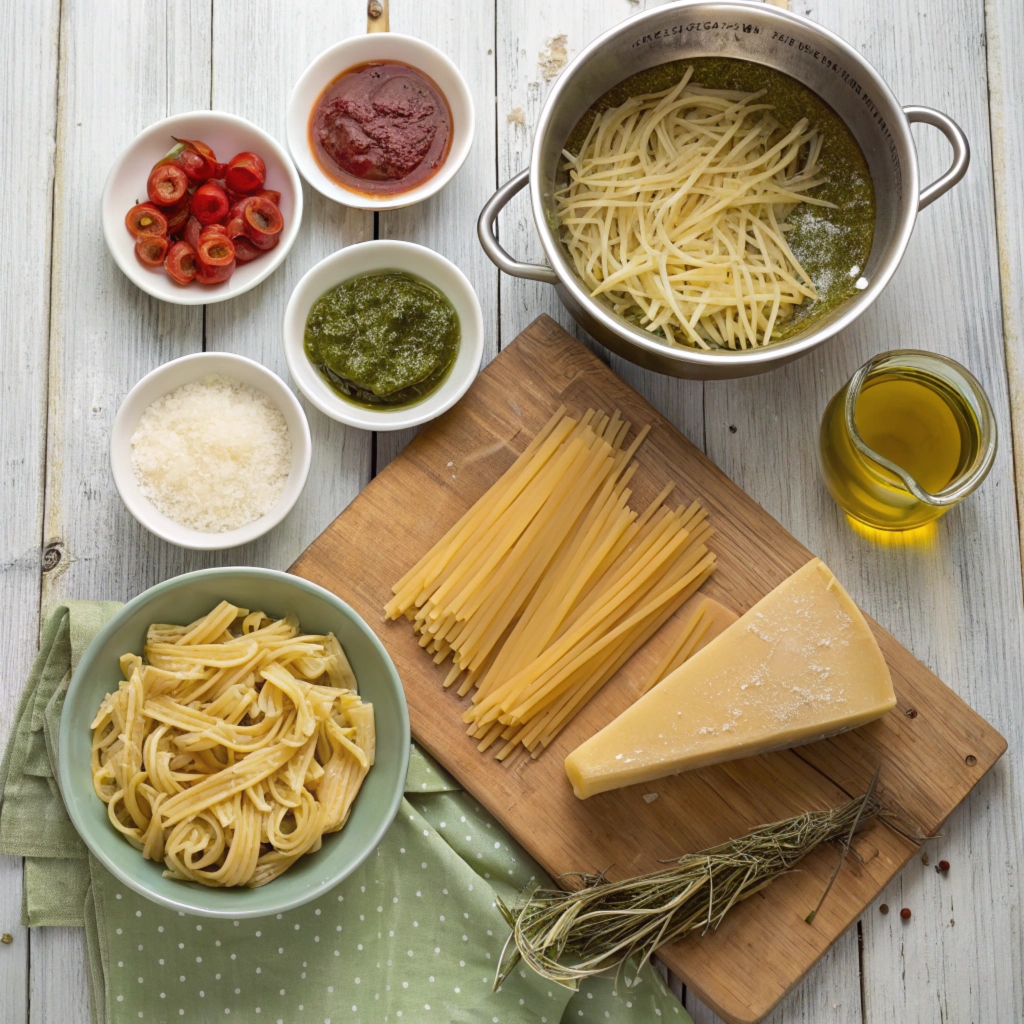The Importance of Choosing the Right Pasta
When it comes to pasta dishes, the type of pasta you use can make or break the meal. This is especially true for iconic recipes like carbonara, where the pasta acts as the dish’s foundation. But have you ever wondered why some kinds of pasta seem to work better than others? It’s not just about looks—shape, size, and texture all play a role in how the pasta holds sauce, interacts with other ingredients, and ultimately, tastes.
In this guide, we’ll explore the best types of pasta for carbonara, how their characteristics influence the dish, and why certain shapes are better suited than others. Whether you’re a spaghetti purist or an experimenter with penne, choosing the right pasta will elevate your carbonara to a whole new level.
“Pasta is like the canvas of a painting—its shape and texture influence how well the sauce clings, creating a masterpiece of flavor.”
How Pasta Shapes Influence Flavor and Texture
The shape and size of pasta are more than just aesthetic choices; they directly affect how the pasta interacts with the sauce.
- Surface Area: Pastas with more surface area, like rigatoni or fettuccine, hold thicker sauces better, creating a richer bite.
- Hollows and Ridges: Tubular or ridged pastas, such as penne or rigatoni, trap sauce inside, delivering bursts of flavor in every bite.
- Thin vs. Thick: Thin pastas like angel hair pair best with light sauces, while thicker ones like spaghetti or fettuccine can handle creamy or heavy sauces without becoming overwhelmed.
Understanding the Role of Pasta in Classic Dishes
In a dish like carbonara, the pasta isn’t just a vehicle for the sauce—it’s a key ingredient.
- Flavor Absorption: The pasta absorbs some of the sauce, ensuring every bite is packed with flavor.
- Textural Contrast: The right pasta provides a satisfying chewiness that balances the sauce’s creaminess.
- Consistency: The starchy water released during cooking helps emulsify the sauce, creating that glossy, restaurant-quality finish.
“The perfect pasta is like a dance partner—it works with the sauce, moving in harmony to create a flawless performance.”
Popular Pasta Types and Their Characteristics
Different types of pasta have different strengths. Let’s break down the most popular options for carbonara and how they perform in this dish.

Spaghetti: A Traditional Favorite 🍝
- Why It Works: Spaghetti is the classic choice for carbonara, and for good reason. Its smooth, cylindrical shape allows the sauce to coat each strand evenly, creating a consistent bite.
- Texture: The moderate thickness of spaghetti provides a nice balance between chewiness and softness, complementing the creamy sauce without overpowering it.
- Cooking Tips: Cook spaghetti al dente for the best texture, as overcooked pasta can turn mushy and lose its ability to hold the sauce.
Fettuccine: A Rich and Creamy Pairing 🍜
- Why It Works: Fettuccine’s wider, flatter shape makes it an excellent choice for creamy sauces, including vegetarian carbonara. The extra surface area allows the sauce to cling beautifully.
- Texture: Fettuccine provides a heartier bite, making it ideal for those who prefer a more substantial pasta.
- Pro Tip: Use fresh fettuccine if possible—it cooks faster and has a silkier texture compared to dried versions.
Penne and Rigatoni: Great for Hearty Sauces 🥄
- Why It Works: These tubular pastas excel at trapping sauce in their hollow centers, delivering bursts of creamy flavor with every bite. The ridges on rigatoni also help the sauce adhere better.
- Texture: Both penne and rigatoni are sturdy, making them perfect for thicker, heartier sauces or versions of carbonara with added vegetables.
- Best Use: These shapes work particularly well if you’re adding chunky ingredients like mushrooms or zucchini to your carbonara.
Angel Hair and Thin Pastas: When to Avoid Them ❌
- Why They Don’t Work: Angel hair and other thin pasta are too delicate for a rich, creamy sauce like carbonara. They tend to get overwhelmed by the sauce, clump together, or break apart during mixing.
- Alternative Use: Save these pasta for lighter dishes, such as those with olive oil or a simple tomato sauce.
“Using the wrong pasta for carbonara is like wearing sandals in the snow—it just doesn’t fit the situation.”
Matching the Best Pasta for Every Dish with Specific Sauces 🍝
Pairing the right pasta with the right sauce is like finding the perfect match—it elevates both elements and creates harmony in every bite. Here’s a breakdown of how different types of pasta work with various sauces and dishes.
Cream-Based Sauces and the Best Long Pasta for Every Dish 🍜
Long, smooth pasta like spaghetti, fettuccine, and linguine are ideal for creamy sauces such as carbonara, Alfredo, or cacao e pepe.
- Why They Work: These pasta provide a balanced surface for rich, velvety sauces, allowing every strand to be coated evenly.
- Best Practices: Toss the pasta and sauce together while the pasta is still hot to ensure a seamless blend. If needed, use starchy pasta water to loosen the sauce.
“Long pastas are the perfect dance partners for creamy sauces, moving together effortlessly for the ultimate bite.”
Chunky Sauces and Tube-Shaped Pastas 🥄
For sauces with hearty ingredients like mushrooms, zucchini, or chunks of meat, tubular pasta like penne, rigatoni, or ziti is the way to go.
- Why They Work: Their hollow centers and ridged surfaces trap chunky ingredients and thick sauces, delivering bursts of flavor in every bite.
- Best Use: These pasta excel in baked dishes or recipes with a mix of textures, like vegetarian carbonara with mushrooms or roasted vegetables.
“Tube-shaped pastas are like little flavor capsules, ready to deliver the perfect mix of sauce and texture.”
Light Sauces and Delicate Pasta Shapes 🌱
Light sauces made with olive oil, garlic, and fresh herbs pair beautifully with thin, delicate pasta such as angel hair or capellini.
- Why They Work: These pasta are best for lighter dishes that don’t overwhelm their fragile structure.
- Avoid for: Heavier sauces like carbonara, as they can clump together and lose their shape.
“Delicate pastas are the summer dresses of the pasta world—light, breezy, and perfect for simple dishes.”
How to Cook Pasta Perfectly Every Time 🧑🍳
Even the best pasta and sauce combination can fall flat if the pasta isn’t cooked properly. Here’s how to achieve pasta perfection every time.
Tips for Al Dente Cooking 🔥
Cooking pasta al dente-“to the tooth”-is all about achieving a firm texture with a slight bite.
- Read the Package: Cooking times vary by brand and type, so use the package as a guideline.
- Taste Test: Begin testing your pasta a minute or two before the recommended cooking time.
- Rinse Sparingly: Avoid rinsing pasta after draining—it washes away the starch that helps the sauce stick.
“Cooking pasta al dente is like finding the sweet spot—it’s all about timing and texture.”
Salt, Oil, and Water Ratios for Cooking Pasta 🧂💧
Getting the pasta water just right is key to great pasta.
- Salt: Use a tablespoon of salt for every 4 quarts of water. The water should taste like the ocean.
- Water: Always use plenty of water—4–6 quarts per pound of pasta—to prevent sticking and ensure even cooking.
- Oil: Skip the oil! It can coat the pasta, making the sauce less likely to stick.
“Salting pasta water is like seasoning a blank canvas—it’s the foundation of flavor.”
Mixing Sauce and Pasta: The Key to Flavor Absorption 🥣
The magic happens when sauce meets pasta, and the right technique makes all the difference.
- Heat Together: Combine pasta and sauce in a hot pan for a few minutes to allow the flavors to meld.
- Use Pasta Water: Add a splash of reserved pasta water to the sauce to loosen it and help it coat the pasta evenly.
- Stir Vigorously: Tossing pasta with sauce ensures every piece is coated, creating a cohesive dish.
“Tossing pasta and sauce is like composing a symphony—each element comes together in perfect harmony.”
Common Mistakes in Pasta Selection and Preparation 🚫
Even seasoned cooks can make missteps when it comes to pasta. Here are the most common errors and how to avoid them.
Choosing the Wrong Shape for the Dish 🤷♀️
Using the wrong pasta shape can throw off the balance of your dish.
- The Problem: Thin pasta like angel hair doesn’t hold up to thick, creamy sauces, while tubular pasta may not work for delicate, oil-based sauces.
- The Fix: Match the pasta’s shape and texture to the sauce—long pasta for cream-based, tubes for chunky, and thin for light sauces.
“The wrong pasta shape is like wearing mismatched shoes—it just doesn’t feel right.”
Overcooking or Undercooking Pasta 😬
Perfectly cooked pasta is the backbone of any great dish.
- The Problem: Overcooked pasta turns mushy, while undercooked pasta is hard and unappetizing.
- The Fix: Stick to the al dente method, testing frequently to ensure the ideal texture. Remember, pasta continues to cook slightly after draining.
“Think of pasta as a marathon runner—pull it out when it’s close to the finish line, and it’ll cross perfectly on its own.”
Failing to Reserve Pasta Water 💧
Pasta water is liquid gold—it’s the secret to achieving a glossy, cohesive sauce.
- The Problem: Draining all the water leaves you without the starchy liquid needed to bind the sauce and pasta.
- The Fix: Always scoop out a cup of pasta water before draining. Use it to adjust the sauce’s consistency.
“Skipping pasta water is like baking without measuring—it’s a small step that makes a big difference.”
Expert Tips for Choosing the Best Pasta for Any Dish 🍝✨
Selecting the right pasta for a dish goes beyond personal preference—it’s about enhancing the flavors, textures, and overall experience. Here are expert tips to help you make the best choice every time.
When to Opt for Fresh Pasta Over Dried Pasta 🥚🍜
Fresh and dried pasta each have unique qualities, and knowing when to use one over the other can elevate your dish.
- Fresh Pasta:
- Best For: Light sauces like cream-based or butter-based dishes (think fettuccine Alfredo).
- Texture: Soft, tender, and slightly chewy, fresh pasta absorbs delicate sauces beautifully.
- Pro Tip: Use fresh pasta for recipes where the sauce is the star and you want the pasta to melt into the dish.
- Dried Pasta:
- Best For: Heavier sauces like tomato-based or chunky meat sauces.
- Texture: Firm and durable, dried pasta holds up to robust, hearty ingredients.
- Pro Tip: Dried pasta is ideal for dishes that need strong structure, such as baked ziti or carbonara.
“Fresh pasta is like silk, while dried pasta is like denim—both have their place in your wardrobe of recipes.”
Considering Texture, Thickness, and Durability 🧑🍳
The texture, thickness, and durability of pasta influence its interaction with sauce.
- Smooth Pastas: Spaghetti and linguine are great for creamy or oil-based sauces. Their surface ensures an even coating.
- Ridged Pastas: Penne and rigatoni excel with chunky sauces as the ridges catch and hold ingredients.
- Thick Pastas: Fettuccine and pappardelle work well with rich, heavy sauces that cling to their wide surfaces.
“Think of texture and thickness as the handshake between pasta and sauce—firm, welcoming, and just right.”
Using Whole Wheat or Gluten-Free Pasta Alternatives 🌾
Alternative pastas cater to dietary needs while offering unique flavors and textures.
- Whole Wheat Pasta:
- Flavor: Nutty and earthy, it pairs well with robust sauces like pesto or tomato-based options.
- Texture: Slightly denser than regular pasta, it holds well in baked dishes.
- Gluten-Free Pasta:
- Flavor: Made from rice, corn, or quinoa, gluten-free pasta is mild and versatile.
- Texture: Can be softer or more brittle, so handle gently and avoid overcooking.
“Alternative pastas are like new friends—they might take some getting used to, but they can surprise you in the best way.”
Frequently Asked Questions About Pasta Types ❓🍝
Choosing the right pasta can feel overwhelming with so many options available. Here are answers to common questions to help you decide.
What Is the Best Pasta for Carbonara? 🥓🍝
For carbonara, long pastas like spaghetti, bucatini, or fettuccine work best.
- Why: Their smooth surfaces and moderate thickness allow the creamy sauce to coat each strand evenly.
- Pro Tip: Cook pasta al dente and toss it vigorously with the sauce to ensure perfect coverage.
“When it comes to carbonara, spaghetti is the classic choice for a reason—it’s timeless and always delivers.”
Can I Use Gluten-Free Pasta for Any Dish? 🌱
Yes, but with some considerations.
- Best Uses: Gluten-free pasta works well in lighter dishes that’re less likely to break apart.
- Cooking Tip: Check often during boiling, as gluten-free pasta can overcook quickly and become mushy.
“Gluten-free pasta is like a delicate flower—handle with care, and it’ll bloom beautifully in your dish.”
What’s the Difference Between Fresh and Dried Pasta? 🧐
The difference lies in their texture, cooking time, and versatility.
- Fresh Pasta: Soft, cooks in 2–4 minutes, and pairs well with light, creamy sauces.
- Dried Pasta: Firm, takes 8–12 minutes to cook, and holds up to heavier sauces and baking.
“Think of fresh pasta as an artisan craft and dried pasta as a reliable staple—each has its own charm.”
How Do I Know Which Pasta to Use with a New Sauce? 🤷♀️
Match the sauce’s texture and richness to the pasta’s characteristics:
- Light Sauces: Pair with thin pasta like angel hair or capellini.
- Rich Sauces: Opt for thick or ridged pasta like rigatoni or fettuccine.
- Chunky Sauces: Choose tubular or wide pasta like penne or pappardelle to trap the sauce.
“The golden rule: let the sauce dictate the pasta—match weight with weight, and you’ll always win.”
Conclusion: Elevating Your Dish with the Perfect Pasta 🎉
Pasta isn’t just a base; it’s an integral part of the dish. By choosing the right type, you can complement your sauce, enhance textures, and transform a good meal into a great one. Whether you prefer the classic elegance of spaghetti, the hearty appeal of rigatoni, or the dietary benefits of gluten-free options, the perfect pasta is always out there waiting for the right dish.
So the next time you cook, consider not just what sauce you’re making, but what pasta will bring it to life. Because in the world of cooking, every little detail matters—and pasta is no exception. Mangia! 🍝✨
Looking for more indulgent cooking ideas? Check out:
The Guide to Perfect Grilled Cheese
A Complete Guide to Gluten-Free Wild Rice
How to Make Delicious Beef Stuffed Shells: Step-by-Step Guide
Neapolitan Pizza Sauce: A Simple, Fresh, and Authentic Tomato Sauce

